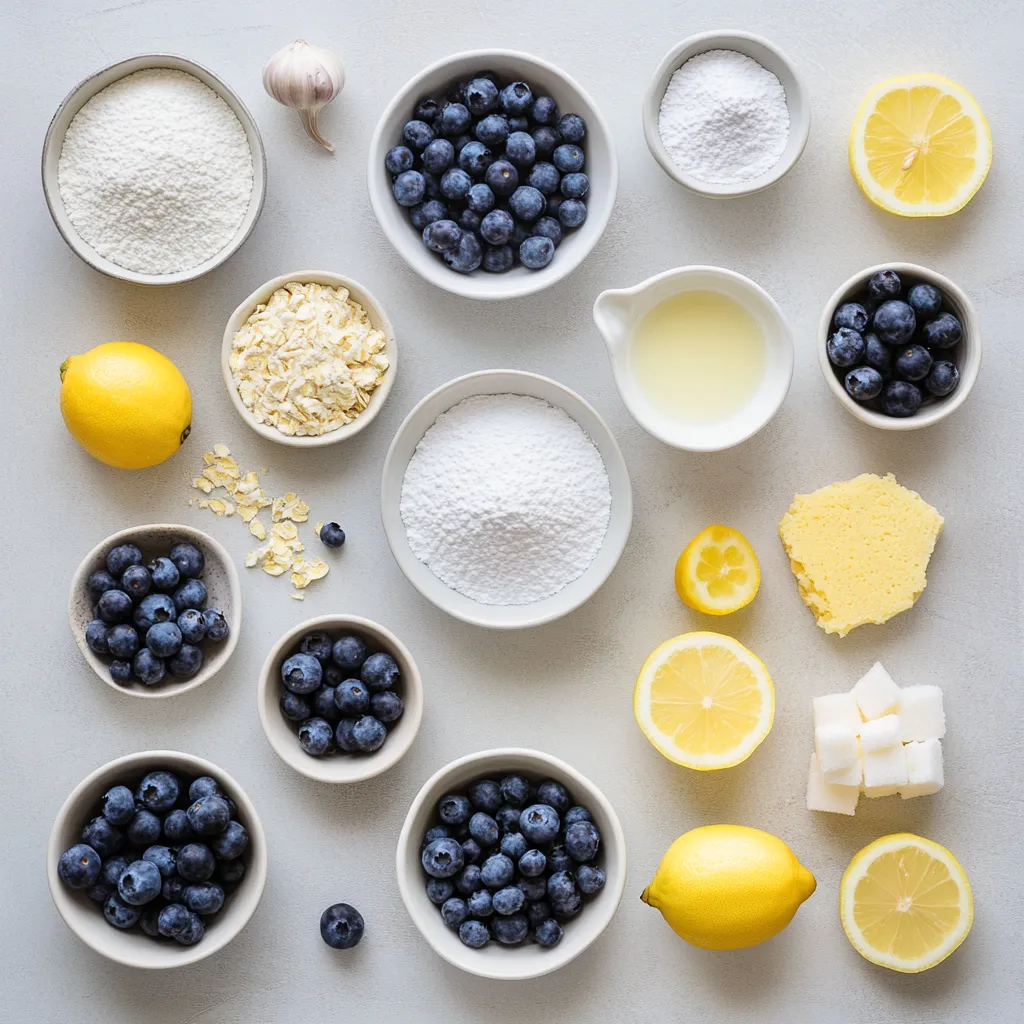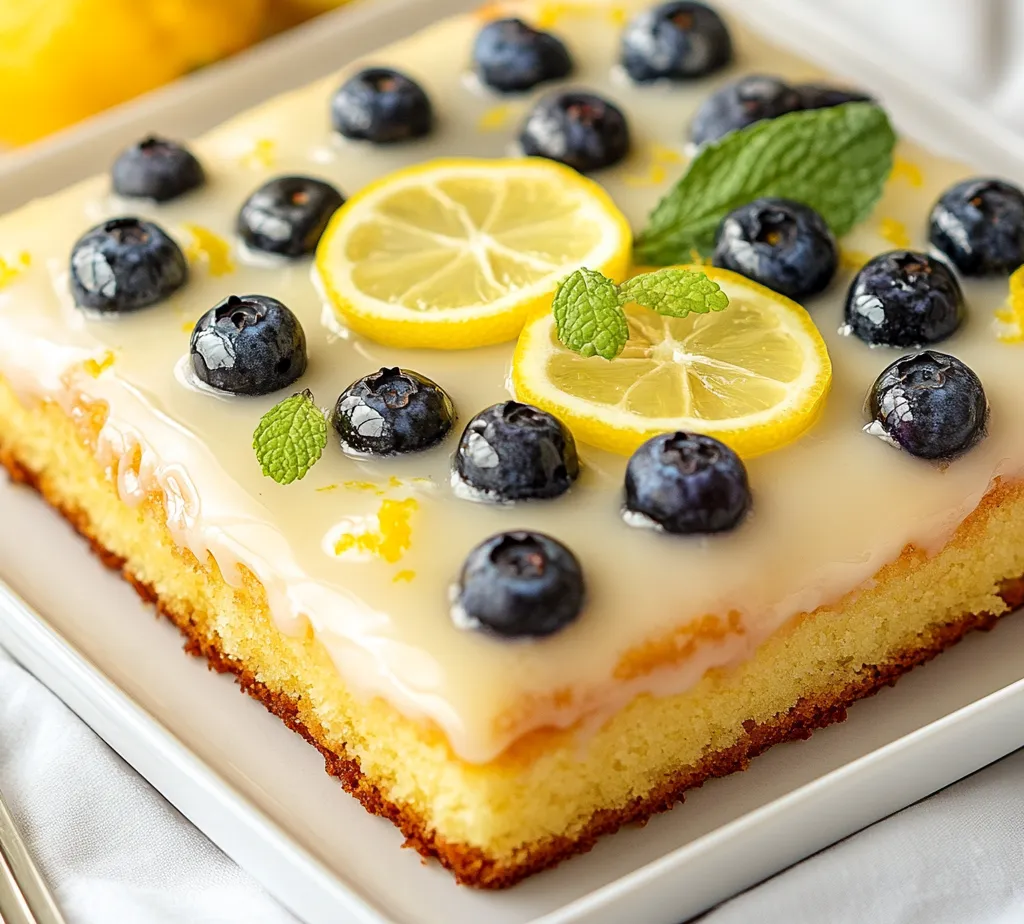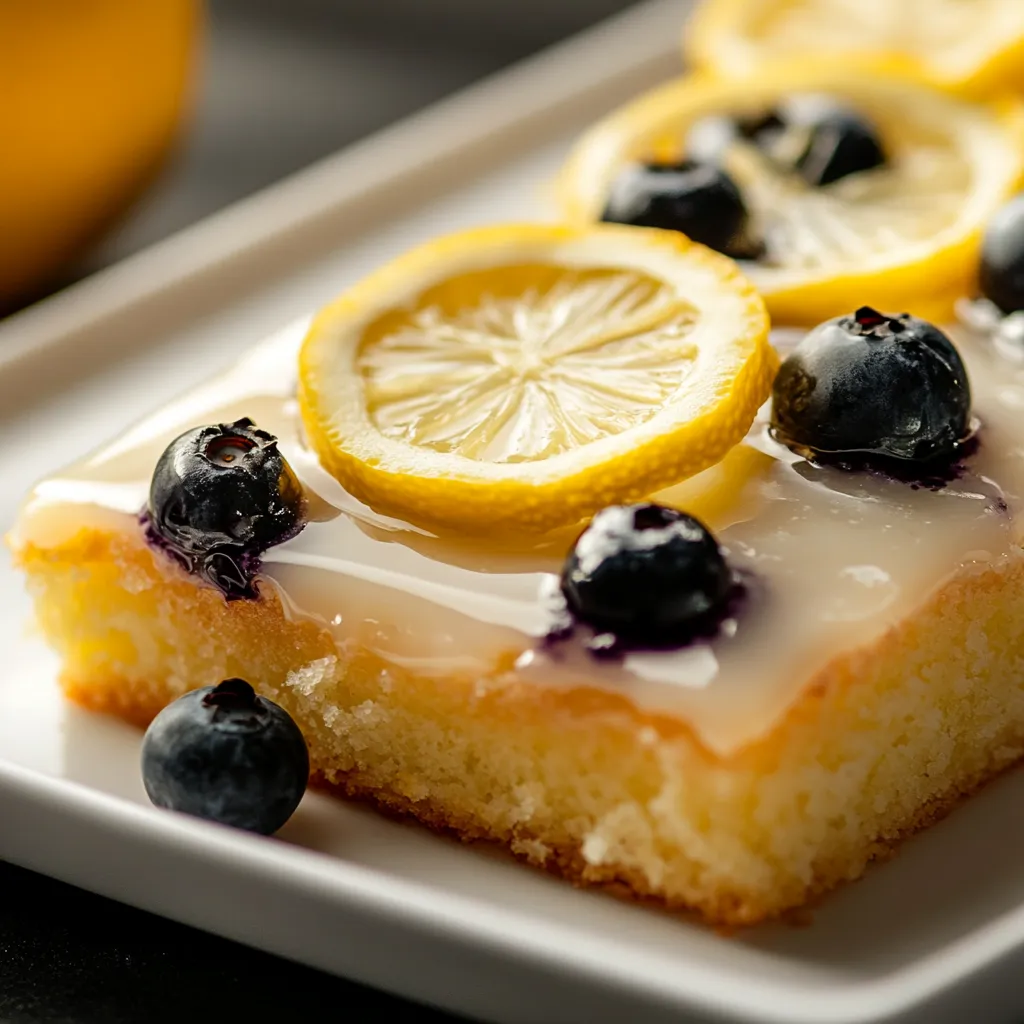Introduction
The Lemon Blueberry Bliss Sheet Cake is a vibrant and delightful dessert that perfectly marries the tartness of fresh lemon with the sweetness of blueberries. This cake has a light and fluffy texture, making it an ideal treat for any gathering, from casual get-togethers to formal celebrations. The refreshing citrus notes paired with juicy blueberries create a flavor profile that is both uplifting and satisfying, leaving an impression on everyone’s taste buds.
This delightful cake is not only visually appealing but also incredibly simple to make. With its inviting aroma and mouthwatering taste, it is an excellent addition to your dessert repertoire. Whether you’re hosting a summer barbecue, celebrating a special occasion, or simply indulging in a sweet treat during the week, this cake is sure to shine.
The beauty of this recipe lies in its straightforwardness, allowing even novice bakers to whip up a stunning dessert with minimal effort. With just a few basic ingredients and an easy-to-follow process, your Lemon Blueberry Bliss Sheet Cake will be a centerpiece that guests will rave about.
Recipe Overview
– Total Time: 50 minutes
– Servings: 12
– Difficulty: Not specified in the recipe
Ingredients
– 1 ½ cups all-purpose flour
– 1 cup granulated sugar
– ½ teaspoon baking powder
– ½ teaspoon baking soda
– ¼ teaspoon salt
– ½ cup unsalted butter, softened to room temperature
– 2 large eggs
– 1 teaspoon pure vanilla extract
– 1 teaspoon freshly grated lemon zest
– ½ cup buttermilk
– 1 cup fresh blueberries (or frozen blueberries, thawed and drained)
– 1 tablespoon fresh lemon juice (for the glaze)
– 1 cup powdered sugar (for the glaze)
– Optional: Extra fresh blueberries and lemon slices for garnish

Instructions
1. Preheat the Oven: Set your oven to 350°F (175°C). Prepare a 9×13 inch baking sheet by greasing it lightly or lining it with parchment paper to ensure easy removal after baking.
2. Mix the Dry Ingredients: In a medium-sized mixing bowl, whisk together the flour, baking powder, baking soda, and salt until well combined. Set this mixture aside for later use.
3. Cream Together Butter and Sugar: In a large mixing bowl, use an electric mixer to beat the softened butter and granulated sugar together. Continue mixing for about 3-4 minutes, or until the mixture is light, fluffy, and pale in color.
4. Incorporate Eggs and Flavorings: Add the eggs, vanilla extract, and lemon zest to the creamed butter and sugar. Beat the mixture until everything is fully combined and smooth.
5. Combine Wet and Dry Ingredients: Gradually mix the dry ingredient mixture into the butter mixture, alternating with the buttermilk. Start with the dry ingredients and end with them, mixing until just combined. Avoid overmixing to keep the cake light and fluffy.
6. Fold in the Blueberries: Gently fold in the blueberries with a spatula or wooden spoon, taking care not to crush them.
7. Transfer Batter to Baking Pan: Pour the cake batter into the prepared baking sheet. Use a spatula to spread the batter evenly across the pan.
8. Bake the Cake: Place the baking sheet in the preheated oven and bake for 25-30 minutes. The cake is ready when a toothpick inserted into the center comes out clean.
9. Prepare the Lemon Glaze: While the cake is baking, whisk together the fresh lemon juice and powdered sugar in a small bowl until the glaze is smooth and free of lumps.
10. Cool and Apply Glaze: Once the cake is baked, remove it from the oven and let it cool in the pan for about 10 minutes. Carefully transfer the cake to a wire rack to cool completely. Once cooled, drizzle the lemon glaze generously over the top.
11. Serve and Garnish: Cut the cake into squares for serving. For an extra touch, garnish with additional fresh blueberries and lemon slices, if desired.
Overview of Lemon Blueberry Bliss Sheet Cake
The Lemon Blueberry Bliss Sheet Cake combines the zest and tang of lemon with the sweetness of blueberries, creating a delightful dessert that is as pleasing to the palate as it is to the eye. The use of fresh ingredients ensures that every bite is bursting with flavor, making it a standout option for dessert tables.
Perfectly portioned for sharing, this cake has a fluffy texture complemented by a light citrus glaze that enhances its overall appeal. It’s an excellent choice for gatherings, family picnics, or even just a cozy dessert at home when you want something sweet yet refreshing. The burst of blueberries in every bite adds a natural sweetness and moisture, complementing the bright lemon flavor effortlessly.
The Perfect Dessert for Any Occasion
This cake is remarkably versatile. It aligns beautifully with summertime celebrations, outdoor barbecues, or picnics in the park. The cheerful colors and fresh flavors make it an appropriate choice for birthdays, anniversaries, or any festive event where you want to impress your guests with a homemade treat.
Seasonal occasions like spring brunches and summer dishes call for light desserts, and this cake fits the bill. It can be served alone or with accompaniments like whipped cream, ice cream, or a side of fresh fruit.
Why This Recipe Stands Out
What sets the Lemon Blueberry Bliss Sheet Cake apart is its simplicity combined with a burst of flavor and visual appeal. Unlike more complex layer cakes, this sheet cake is straightforward to prepare, allowing bakers of all skill levels to produce an impressive dessert. The one-bowl method for mixing reduces cleanup time while ensuring that the final product is consistent and delicious.
Moreover, the recipe utilizes familiar ingredients that are often staples in many kitchens, making it cost-effective and accessible. The balance of tangy lemon and sweet blueberries not only excites the taste buds but also offers a refreshing angle on traditional cake recipes, making it a must-try for anyone looking to elevate their baking game.
Ideal Serve Size and Portions
The Lemon Blueberry Bliss Sheet Cake yields about 12 servings, making it a great option for serving at small gatherings, parties, or for a family dessert. Each square slice portends a generous portion, ensuring that everyone gets their fill of the delightful combination of lemon and blueberry flavors. This portioning allows for easy planning and serving, as individuals can help themselves to a piece whenever they desire.
Preparation and Cooking Time
The total preparation and cooking time for this scrumptious sheet cake is just 50 minutes, with about 15 minutes dedicated to prep work. The baking time falls within the range of 25 to 30 minutes, allowing you to fit this recipe into a busy day without the need for extensive time commitment. The relatively short baking time means you can have a delicious dessert in no time, perfect for last-minute events or impromptu gatherings.
Flavor Profile and Textural Elements
The flavor profile of this cake is bright and refreshing, perfect for those who appreciate a mix of sweet and tart flavors. The sweetness from the granulated sugar complements the natural sugars found in the blueberries, while the tangy notes of lemon zest and juice create a vibrant backdrop. The texture of the cake is light and airy, thanks to the careful mixing and folding techniques used, ensuring that every bite is moist yet fluffy.
The glaze adds a finishing touch, providing a glossy surface that not only looks appealing but also enhances the overall flavor. Overall, the Lemon Blueberry Bliss Sheet Cake offers a well-rounded taste experience that appeals to a variety of palates, making it an ideal choice for serving guests.

Ideal Mixing Time for Best Results
Achieving the perfect texture in a cake relies heavily on how ingredients are mixed during preparation. When creaming the butter and sugar, allowing sufficient time for this step is crucial. Aim for about 3-4 minutes when using an electric mixer on medium speed. This duration allows the sugar to fully dissolve in the butter while incorporating the necessary air into the mixture, ultimately leading to a light and airy cake.
Signs of Perfectly Creamed Butter
The ideal creamed butter and sugar mixture should appear pale and fluffy. You can recognize this stage when the mixture doubles in volume and has a light texture that leaves a ribbon-like effect when drizzled from a spatula. If it seems grainy or overly dense, it might need more mixing. However, be cautious, as excessive mixing can lead to a tough cake due to gluten formation.
Incorporating Eggs and Flavorings
Mixing Strategy for Homogeneity
Integrating the eggs and flavorings into the creamed butter and sugar picture is straightforward but vital for flavor development. Once the eggs are added, continue to beat the mixture at medium speed until completely smooth and fully incorporated. Ensure that no visible streaks of butter or eggs remain. This not only yields a uniform batter but also helps in emulsifying the mixtures, contributing to the overall stability of your cake.
Tips for Adding Ingredients Gradually
When adding the eggs, vanilla extract, and lemon zest, consider breaking the eggs into a separate bowl before incorporating them into the batter. This technique helps prevent any potential shell fragments from mixing into your cake batter and allows for easier monitoring of the egg’s quality and freshness. A steady, gradual addition also ensures that each egg is fully absorbed before adding the next, which helps maintain the airiness of the batter.
Combining Wet and Dry Ingredients
The Importance of Alternating Mixing
When combining the dry ingredients and the wet ingredients, employ a methodical approach by alternating the additions. Start by adding a third of the dry mixture, followed by half of the buttermilk, and repeat this process until both are fully incorporated. This technique aids in achieving a balanced and well-integrated batter, ensuring that the buttermilk’s acidity interacts ideally with the leavening agents.
Techniques to Avoid Overmixing
To prevent overmixing, which can result in a dense cake texture, mix only until you can no longer see flour streaks. The batter may appear slightly lumpy; this is perfectly acceptable. The folding technique for the blueberries in the next step will help smoothen out the batter without excess handling.
Consistency to Aim For
The final batter consistency should be somewhat thick yet pourable; think of a smooth pudding-like quality. It should mound slightly on itself when spooned. If the batter appears too runny, it’s a signal that too much liquid has been added, while overly thick batter indicates insufficient mixing of the wet and dry ingredients.
Folding in the Blueberries
Techniques for Gentle Folding
Folding in the blueberries requires a delicate touch to keep the berries intact. Use a rubber spatula or a wooden spoon to gently lift the batter and fold it over the blueberries rather than stirring. This technique ensures that the berries remain whole, providing delightful bursts of flavor throughout the cake.
Importance of Preserving Blueberry Integrity
Preserving the integrity of the blueberries is essential in achieving the visual appeal and taste of the cake. Whole berries contribute a delightful texture contrast within the moist cake. If the blueberries are crushed, they could create bluish streaks throughout the batter, which can affect the visual presentation.
Ensuring Even Distribution
To ensure even distribution, gently turn the bowl as you fold, making sure all berries are encased in the batter. This step is just as crucial for flavor as it is for presentation, as each slice of the cake should equally enjoy the tangy sweetness of the blueberries.
Baking the Cake
Oven Temperature Precision
For optimal results, maintaining an accurate oven temperature is non-negotiable. An oven thermometer is a worthwhile investment if your oven tends to run hot or cold, as even slight temperature deviations can impact the baking time and cake texture.
Preheating Significance
Preheating the oven to 350°F (175°C) allows for even cake rising. Ensuring the oven reaches the set temperature before placing the cake inside promotes an even rise and helps develop a golden crust, contributing to a pleasing texture contrast.
Recognizing When the Cake is Done
Watch for visual cues to ascertain doneness. The cake should gently pull away from the edges of the pan and spring back lightly when pressed in the center. If uncertain, use a toothpick inserted into the center to check for doneness; it should come out clean or with a few moist crumbs attached.
Preparing the Lemon Glaze
Ideal Consistency for the Glaze
The glaze should be smooth and pourable, suitable for drizzling but not so runny that it loses shape on the cake. A good rule of thumb is to mix until you achieve a thick yet fluid consistency, allowing the glaze to flow easily while retaining its shape.
Common Mistakes and How to Avoid Them
Avoid over-adding lemon juice to the glaze, which may lead to a too-thin consistency. Conversely, adding too much sugar can make it overly thick. Adjust carefully, testing with small amounts until the desired consistency is achieved.
Timing for Glaze Application
Timing is vital when applying the glaze. For best results, apply the glaze when the cake is completely cooled, as warm cake could absorb the glaze, leading to a less attractive finish. Letting the glaze set for a few minutes adds an appealing sheen that elevates the cake’s presentation.
The Impact of Glaze on Cake Moisture
The glaze not only adds sweetness and flavor but also seals in moisture. A well-glazed cake will stay fresh longer as it helps maintain its soft texture.
Cooling and Serving
Importance of Proper Cooling
Allowing the cake to cool appropriately is vital for enhancing flavor and texture. If the cake is removed from the pan too soon, it may crumble or fall apart. The cooling process allows the steam to escape, ensuring a firm structure that holds its shape once sliced.
Methods for Cooling the Cake Correctly
To cool the cake properly, lift it from the pan onto a wire rack after letting it sit for about 10 minutes. This allows airflow around the cake, preventing moisture accumulation on the bottom and ensuring a well-set texture.
Presentation Tips for Serving
When time to serve, cut the cake into squares, offering a generous portion per serving. Utilizing a rustic wooden board or colorful plate can create an inviting presentation. Lay garnishes like fresh blueberries and lemon slices in an artistic manner to enhance the visual impact, inviting guests to indulge.
Artistic Arrangements with Garnishes
Combine blueberries and lemon slices in a scattered arrangement around the cake, or create a whimsical pattern on top of the glaze. Such thoughtful touches not only enhance the aesthetic appeal but also hint at the flavors within, enticing everyone to take a slice.
Flavor Enhancements
Using Fresh Blueberries and Lemon Slices
Utilizing fresh blueberries brings a burst of natural sweetness and a slight tartness that balances beautifully with the lemon. Garnishing with lemon slices not only enhances the flavor profile but also adds freshness to each serving.
How Garnishes Elevate the Presentation
Simple garnishes elevate presentation significantly. A sprinkle of lemon zest or an extra drizzle of glaze can add texture contrast and visual interest, making each plate not just dessert but an enjoyable visual experience.
Pairing Suggestions
Ideal Drinks to Accompany the Cake
This Lemon Blueberry Bliss Sheet Cake pairs delightfully with beverages like iced tea, lemonade, or even a light and fruity wine. The refreshing notes in each drink complement the cake, enhancing the overall experience.
Storage and Shelf Life
Best Practices for Cake Storage
Store the cake covered at room temperature for up to three days. If you plan to keep it longer, opt for refrigeration in an airtight container to maintain its freshness without sacrificing flavor.
Keeping It Fresh Over Time
Utilizing plastic wrap or aluminum foil can prevent the cake from drying out. If sliced, ensure each portion is wrapped to preserve the cake’s moisture.
Reheating Tips for Leftovers
How to Restore Moisture and Flavor
For reheating, place individual slices on a microwave-safe plate and cover them with a damp paper towel to maintain moisture. Heat each slice in short intervals, about 10-15 seconds, checking for warmth. Overheating may dry it out but should be sufficient to warm the flavors back to life.
Conclusion
This Lemon Blueberry Bliss Sheet Cake showcases a beautiful interplay of sweet and tart flavors, highlighted by the moist crumb and the delightful pop of blueberries. With minimal preparation time and a total cooking period of around 30 minutes, it offers an accessible yet impressive dessert option. The refreshing lemon glaze completes the cake, making it a wonderful treat for any occasion.

Lemon Blueberry Bliss Sheet Cake Recipe
Ingredients
- 1 ½ cups all-purpose flour
- 1 cups granulated sugar
- ½ teaspoon baking powder
- ½ teaspoon baking soda
- ¼ teaspoon salt
- ½ cups unsalted butter softened
- 2 large eggs
- 1 teaspoon pure vanilla extract
- 1 teaspoon freshly grated lemon zest
- ½ cups buttermilk
- 1 cups fresh blueberries
- 1 tablespoon fresh lemon juice for the glaze
- 1 cups powdered sugar for the glaze
- Extra fresh blueberries and lemon slices for garnish
Instructions
- Preheat the oven to 350°F (175°C) and prepare a 9x13 inch baking sheet.
- In a bowl, whisk together flour, baking powder, baking soda, and salt.
- In a large bowl, cream together butter and sugar until light and fluffy.
- Add eggs, vanilla extract, and lemon zest to the butter mixture and mix until smooth.
- Gradually mix in the dry ingredients and buttermilk, alternating until just combined.
- Fold in the blueberries gently.
- Pour the batter into the prepared baking sheet and spread evenly.
- Bake for 25-30 minutes until a toothpick comes out clean.
- Prepare the glaze by whisking lemon juice and powdered sugar until smooth.
- Cool the cake, drizzle with glaze, and garnish before serving.

